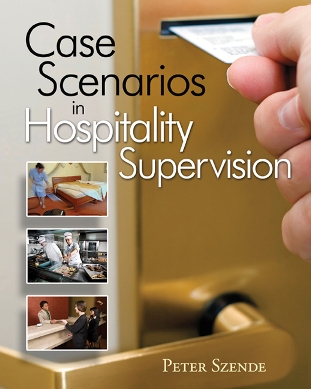Using Case Studies to Bridge the Gap between Classroom and Industry
15 July 2010By Samuel Glass, M.Ed., CEC, CCE, AAC
 One of the more unique benefits of using case studies in teaching is the “investment of mental energy,” which ultimately results in enhancing critical-thinking skills.
One of the more unique benefits of using case studies in teaching is the “investment of mental energy,” which ultimately results in enhancing critical-thinking skills.
As an educator, I have found that too often there is a perceived difference between the theory being taught in the classroom and the reality of industry. One way to address that gap is the use of case studies. In using case studies, the lessons learned from reality can be used as part of a theoretical approach to learning that focuses not only on the concept of learning from mistakes, but the application of best practices, as well.
Dr. Peter Szende, from Boston University, is the author of Case Scenarios in Hospitality Supervision (Delmar Cengage Learning, 2010). At the recent CAFÉ Leadership Conference, Szende facilitated a breakout session titled “Using Case Studies to Bridge the Gap between Classroom and Industry” in support of his recently published book. The book is based on the journaling of his experiences and personal challenges during his hospitality career prior to academia.
In this interactive session, Szende explained the benefits of using case studies for both educators and students. According to Szende, a case study should be the “distillation” or summary of events, with the data being complex and allowing for alternative courses of action. Szende also noted that case studies add variety to traditional methods of curriculum delivery.
One of the more unique benefits, as identified by Szende, is the “investment of mental energy,” which often results in inspired learning founded on dialogue rather than rote learning, ultimately enhancing critical-thinking skills. Other benefits include allowing students to assume the role of decision makers, creating “stimulating conflicts,” as well as bridging the gap between industry and students. Another benefit, although not identified by Szende, is the richness found in the sharing of the human experience with friends, students and colleagues.
In preparing for management roles, Szende noted that managers require two core competencies: soft (people) skills and hard (technical) skills. The use of case studies can often prepare them for those core competencies. Those initial core competencies will vary from student to student because of the current student demographic, in which, according to Szende, some students have industry experience, while others have none.
Szende also shared the way in which he develops case studies. The first step is to identify a learning objective and then select a case presentation style. Once that is done, a setting and characteristics are added, followed by directions and discussion questions. The next step is to develop teaching notes. Then the case study is tested and feedback is given. The final step is revision, founded on feedback. The benefit of this development template is that students can be asked to develop case studies and take further ownership of their learning, something that Szende advocated in the presentation.
For hospitality and culinary educators teaching management skills, case studies offer a refreshing way to present the curriculum in a refreshing manner that encourages participatory learning through student engagement. Szende’s book and presentation were able to reinforce that idea, and I would encourage educators to integrate more case studies as part of their program/curriculum delivery.
Samuel Glass, M.Ed., CEC, CCE, AAC, is a chef and professor at Centennial College’s School of Hospitality, Tourism & Culture in Toronto.
